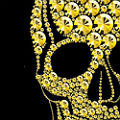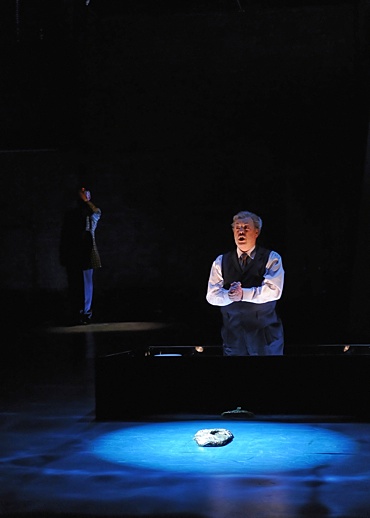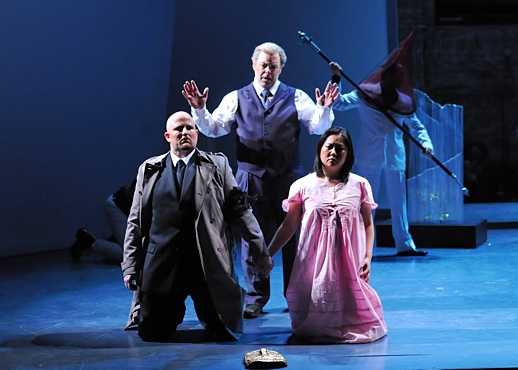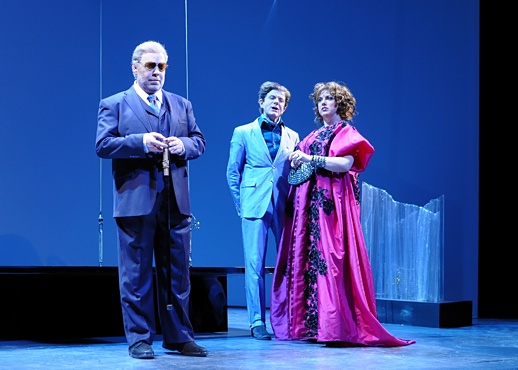
He was right. And neither were the other eighty-three. Hindemith’s opera is so concise, and this production of it so unrelenting and engrossing, that during the curtain calls I wanted to ask them to do it all again so I could take in more of its rich details.
Opera Boston presents the three acts contiguously, so as to keep the momentum driving forward. Cardillac is about so many things: desire, both for people and for objects; possessiveness; the relationship of an artist to his work, and to the public; the power and changeability of crowds; the danger of dealing only in extremes and absolutes. Yet it is tightly written, and the vivid performances and breathless pace works beautifully.
Cardillac is a jeweler who is so in love with his own creations that he cannot bear to let go of them: he pursues everyone who purchases one of his pieces, kills them, and retrieves his beloved handiwork. The public covets his work even while it lives in fear of the murderer preying upon the city.

Sanford Sylvan as Cardillac
The ensuing action, involving a Lady and a Cavalier; Cardillac’s nameless Daughter and her lover, the Officer; and a hapless Gold Merchant, raises question about the meaning of love, desire, and possession. In Cardillac, all of these bleed together to the margins of extremity. The Officer will only be satisfied with the Daughter’s love if she renounces her father to become his entirely. Cardillac loves and desires his creations so desperately that he resorts to murder in order to possess them. In the end, it is only the mob’s threat to destroy them that brings forth his confession.
It also raises questions about the meaning of art and the role of the artist. Do people desire Cardillac’s creations for their beauty, their prestige, or their inherent danger? The danger of the situation sparks the Lady’s and the Cavalier’s desire, and they turn Cardillac’s beautiful mask into a bedroom prop. The Officer buys the mask as a challenge to Cardillac and uses it as bait to unmask the murderer. If Cardillac felt that other people were truly worthy, would he kill to take back his creations?
And what about the crowd’s adulation for Cardillac? Is the artist a privileged figure, or does Cardillac have the same responsibilities as other citizens? Is their hero-worship any less scary than their unleashed anger when they finally beat him to death? What about the government: should it be allowed unlimited power under the guise of protecting its citizens and exacting justice?
As a chilling and yet human Cardillac, baritone Sanford Sylvan sang with a velvet tone and beautiful dynamic range, even when expressing the coldest of emotions. Deliberate physical movements created a sense of menace while his impassioned singing justified Hindemith’s wish that audiences would sympathize with the murderous jeweler. When the Cavalier tears the golden mask from Cardillac’s grip, Sylvan stares at his hands, not only in disbelief at losing a beloved object, but evoking simultaneously an artist and a murderer contemplating what his hands have wrought.
Sol Kim-Bentley shone in the role of Cardillac’s Daughter, singing with power and passion. The Daughter is the most like ordinary people: among characters who deal only in absolutes, she lingers in uncertainty. Perhaps it is that resemblance to ourselves that makes her all the more moving. Kim-Bentley was especially heartbreaking in the last scene, not just in the purity of her vocal tone but in embodying the character’s absorption in mourning her father.
The Daughter’s costumes underscore her sheltered upbringing: a simple dress and blazer and sensible shoes, and in the third act a girlish pink nightgown. (Contrast this pale pink cotton to the Lady’s fiery magenta silk, and the Daughter’s romantic caution to the Lady’s sexual abandon.)

Steven Sanders (The Officer), Sanford Sylvan (Cardillac) and Sol Kim Bentley (The Daughter)
With his clarion voice and assured stage presence, tenor Steven Sanders made an excellent Officer. The vocally striking baritone David Kravitz offered an endearing, sympathetic Gold Merchant. Mezzo-soprano Janna Baty, as the Lady, and tenor Frank Kelley, as the Cavalier, both turned in impressive performances, culminating in their night of sadomasochistic sexual abandon after the Cavalier wins her favor.
Gil Rose conducted the uncompromising, contrapuntal score with vigor and drew a wealth of tone colors from the chamber-sized orchestra. The ensemble tilts heavily toward the woodwinds, and the wind playing – particularly in the coy flute duet that accompanies the bedroom encounter between the Lady and the Cavalier – was exquisite. The small complement of strings, too, found a rich palette of timbres.
Overall, the balance was excellent. The Officer was occasionally overpowered in ensembles and in a duet with Cardillac, but only when he was placed upstage of the others.
Director Nic Muni brought the opera up to the present day, but as Richard Dyer noted in a post-concert talk, with the eye of “someone who’s seen a lot of German movies of the 1920s.” Though there’s a flat-screen TV onstage, and a cell phone, and suits that wouldn’t look out of place on today’s street, there’s more than a hint of Weimar decadence.
Gabriel Berry’s detailed and often spectacular costume design, with its touches of fetish wear, contributes significantly to the echoes of Weimar. The chorus in Act I, for example, is costumed in outrageous textures and revealing cuts: lots of lace, a little leather, lots of cleavage, a little cross-dressing. The edginess is tempered by the subtle shades of gray and brown. All of them loll around with an insouciant manner that suggests they’d be up for anything. Which, of course, they are: by Act III, they’ve devolved into a more depraved and dangerous animal.
Though the libretto calls for multiple locations, in this production Cardillac’s gallery/workshop becomes the primary setting. Erhard Rom’s minimalistic set – asymmetrical sloping walls, icy oversized light fixtures, a sleek black platform and matching overhang – evokes both the present day and early twentieth-century design. The simplicity belies the mechanisms that allow set pieces to fly, to surprising, dramatic, and sometimes even humorous effect.

Sanford Sylvan (Cardillac), Frank Kelley (The Cavalier) and Janna Baty (The Lady)
The onstage TV is not a mere gimmick. When Cardillac’s gallery is open, it advertises his finest creations; with the announcement of the Chambre Ardente, it displays chilling imagery to illustrate the the king’s special new tribunal.
The slanted white walls provide a surface for Christopher Ostrom’s lighting design to heighten the drama. Shadows loom constantly, from the silhouette of Cardillac stalking the silent opening to the monstrous scenes of torture seen only in outline. Not only is the shadow play reminiscent of 1920s German film, but it emphasizes the anonymity, and therefore the universality, of the characters. (Only Cardillac has a name. Everyone else is just described: his Daughter, the Lady, the Gold Merchant.)
In place of the belt specified in the libretto, here the most coveted of Cardillac’s creations is a golden mask. In the opening scene, as the chorus lolls around Cardillac’s gallery drinking, smoking, and admiring the jewelry, it is the image of this piece on the television that sucks in everyone’s attention like a sudden thirst. Thus the lust for this object is set up, and one by one, the characters fall.
Other directorial choices create similar moments of resonance. At the opera’s very beginning, even before the overture, the Daughter and the Officer share a brief, passionate rendezvous. By establishing their characters and their connection, this moment adds weight to the decision the Daughter must later make.
During the Lady’s aria, in which she sings about her desire and the allure of death, Cardillac looms behind her: he, too, is drawn to desire and death. In fact, he is onstage through much of Act I, even though he doesn’t sing until Act II; his presence adds a layer of meaning to the adulation of the crowd and underscores the danger of desiring his works.
Cardillac’s golden creations may be objects of desire, but money does not have the same luster. We never see coins or bills; money is not given hand-to-hand. Instead, coin purses are thrown down, like gauntlets, as a challenge. So is the bag of gold that Cardillac accuses the Gold Merchant of being impure. His desire for the material is so strong that he breathes in the smell of the metal with an emotion close to lust.
This production marked the New England premiere of Hindemith’s 1926 opera, and one of the only productions in this country since its American premiere over forty years ago. It’s received several productions in Europe, but not here. Though Hindemith was only 30 when he wrote Cardillac, his first full-length stage work, it’s a fully fledged piece. With this taut, powerful production, Opera Boston has made a case for bringing Cardillac into the North American repertory.





Comments